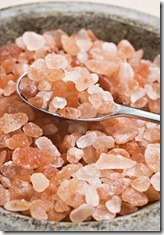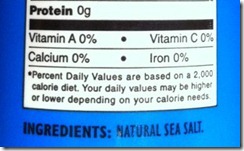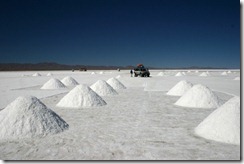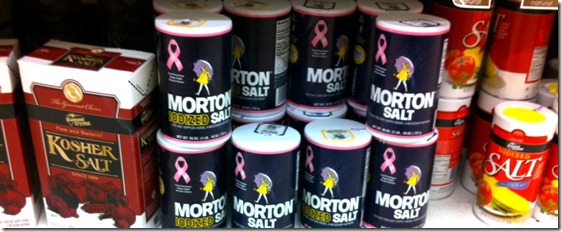Is Sea Salt Healthier than Table Salt?
 I’d like to consider myself a savvy consumer, at least when it comes to food. So it’s a bit annoying when I realize that I’m buying something just because the packaging is pretty or I saw a flashy advertisement selling it to me. However, I’ve got to occasionally give credit where credit is due…
I’d like to consider myself a savvy consumer, at least when it comes to food. So it’s a bit annoying when I realize that I’m buying something just because the packaging is pretty or I saw a flashy advertisement selling it to me. However, I’ve got to occasionally give credit where credit is due…
There is a certain amount of advertising genius behind the "natural sea salt movement." I don’t watch too much Mad Men, but the advertising story surrounding salt seems so made-for-TV that I can almost envision a Madmen episode on this (feel free to contact me Hollywood)!
I’m pretty sure that the advertising discussion for salt must have gone something like this:
“OK Joe, how should we advertise this salt?”
“Well, we’ll claim that it’s the most exciting new culinary invention in decades!!”
“But Joe, it’s been around for millennia…”
“Um, how about we claim that salt is so scarce that only a few lucky individuals will have the opportunity to enjoy it?”
“But JOE! EVERYONE can buy it already!”
“I’ve got it – We’ll create new kinds of salt. We’ll even make some of them PINK!”
And lo and behold, the salt guys had their “Aha” moment. Think about this for a minute – when you go to a normal grocery store, there are approximately 322 different types of salt on the shelves. Really – go count them.
The salt industry went and CREATED what are essentially new, better, and more desirable salts. Who would otherwise pay 10 times the normal price of salt just because the salt granules were PINK?? I’m sure, all the way back in 1971 when Starbucks was born, it was also crazy to think that anyone would pay $3 for a cup of coffee, but Starbucks seems to be doing just fine.
Now, the bigger question is: Should we be paying more for certain types of salt?
Salt, the Other Kind of Salt, and the Other Kind of Salt
There are 3 main types of salt that you’ll find at the store: table salt, sea salt, and kosher salt. (There’s also unrefined salt, which is generally sea salt that hasn’t gone through a refining process – I’ll get to unrefined salts later, but note that it’s only unrefined if it’s specifically labeled as such.) Most table salt is that cheap fine white powder (think Morton). Then there’s those pink rocks and the exotic salts – they’re usually all different types of sea salt, and when I say different types, I actually mean similar chemical compounds placed in pretty jars with labels that make you think each one of them is “special.” And kosher salt is, well, kosher salt – it’s also labeled very clearly as kosher salt!
α, β, ϒ Let’s Analyze Salt: Is sea salt or kosher salt better chemically than table salt? Well, salt is simply the chemical compound, NaCl (sodium chloride). No matter what type of salt you buy, table salt, sea salt, and kosher salt each have at least 97% NaCl (it’s part of the Codex Alimentarius Standard). So whether you’re spending $1 on that huge bag of table salt or $10 on that tiny jar of cute pink crystals, you’ll be consuming 97% the same thing.
What’s the other 3%? You’re thinking that maybe the other 3% makes up for that 10-fold difference in price? That’s certainly what the salt industry seems to want us to believe. In truth, however, that other 3% is not so important or crucial as we might hope:
In table salt, that other 3% is usually just more NaCl, along with a tiny bit of anti-caking ingredients.
 In sea salt, that other 3% is often other trace minerals such as magnesium, potassium, sulfates, and bromides. You’ve probably heard that you need those minerals and that’s why sea salt is so much better for you, but let’s step back just a bit… They are called “TRACE” minerals for good reason – there’s only TRACE amounts of them in the salt!
In sea salt, that other 3% is often other trace minerals such as magnesium, potassium, sulfates, and bromides. You’ve probably heard that you need those minerals and that’s why sea salt is so much better for you, but let’s step back just a bit… They are called “TRACE” minerals for good reason – there’s only TRACE amounts of them in the salt!
Kosher salt, as I’ll explain below, can be either table salt (derived from underground deposits) or sea salt, meaning that the other 3% in Kosher salt matches either table salt or sea salt, as applicable.
At this point, I need to take a quick detour to talk about unrefined salts, which can be a subcategory of table salt, sea salt, or kosher salt. Unrefined salts are actually a fair amount different from the usual refined salts that you find in most supermarkets. Unrefined salts often contain much less NaCl and much more trace minerals. For instance, a typical unrefined salt might be 70% NaCl and 30% other minerals. That’s good right? Yes, but before you run off to the store to get your unrefined salt in order to bulk up on your lost minerals, keep in mind that you’re still going to need to eat A LOT of unrefined salt to actually have it make any difference. You’d probably be better off spending the money on some multi-vitamins. Otherwise, you’ll just be overloading on sodium and remain deficient in everything else!
Surely there must some differences in the manufacturing processes of different salts, right?
 Although the labels make the salt sound so exotic (Hawaiian black lava sea salt is definitely a winner in my mind), salt really comes from just two general places – salt mines (deposits of salt underground) or evaporated seawater. The country that the salt comes from really doesn’t matter – it’s the difference between drinking sea water in Florida versus in Sicily: it’s all just seawater. Table salt is mined from salt deposits underground. Sea salt comes from the sea (shocking!) – it’s evaporated seawater.
Although the labels make the salt sound so exotic (Hawaiian black lava sea salt is definitely a winner in my mind), salt really comes from just two general places – salt mines (deposits of salt underground) or evaporated seawater. The country that the salt comes from really doesn’t matter – it’s the difference between drinking sea water in Florida versus in Sicily: it’s all just seawater. Table salt is mined from salt deposits underground. Sea salt comes from the sea (shocking!) – it’s evaporated seawater.
Kosher salt can come from either underground deposits or seawater – what’s “special” about the salt is that it contains no additives (e.g., no iodine), and it has been certified as kosher by a rabbi or other authorized organization. Kosher salt originates from preparing foods such as meats according to Jewish law, which prohibits the consumption of any blood in the meat. The large granules of kosher salt is therefore perfect for drawing out traces of blood from the meat. If fine granules of table salt was used, it’d quickly dissolve once placed on the meat resulting in very salty meat. Kosher salt is often advertised as “better” because it’s pure with no additives. However, the main additive that they’re talking about is iodine. Remember those seriously disgusting lumps protruding from the necks of people with goiter? Yeah, that’s called IODINE DEFICIENCY! Iodine was especially added into salt to help with this problem, much like fluoride is added into tap water to prevent tooth decay.
So I’m confused now, is there ANY real difference?
Surprisingly, yes – but just not for the reasons that advertisers (those genius madmen) wanted you to believe. There is a distinct difference in the texture and, to some degree, the taste. Table salt is much finer than sea salt or kosher salt, which means that there is a lot more salt in one tablespoon of table salt than of sea salt or kosher salt. So when substituting one type of salt for another when following a recipe, you should remember that 1 tablespoon of kosher salt/sea salt = 3/4 tablespoon of table salt (although this equation can vary a bit as the granule sizes often vary from brand to brand). Table salt is also better for baking as its fine granules mix more easily into the dough. As to taste, some people say that table salt has a sharper taste than kosher or sea salt. I personally tend not to eat salt all by itself, and once blended into the food, it really just tastes salty to me.
So what should you do when you see one of those carefully manicured jars of softly colored rocks of salt screaming “BUY ME, BUY ME – I’m Natural, I’m Healthy, I’m way Better Than The Rest” as you walk down the supermarket aisle? Take it with a grain of salt – it’s all salt! (Don’t cringe and shake your head now – you had to know that I’d squeeze that joke in!)

